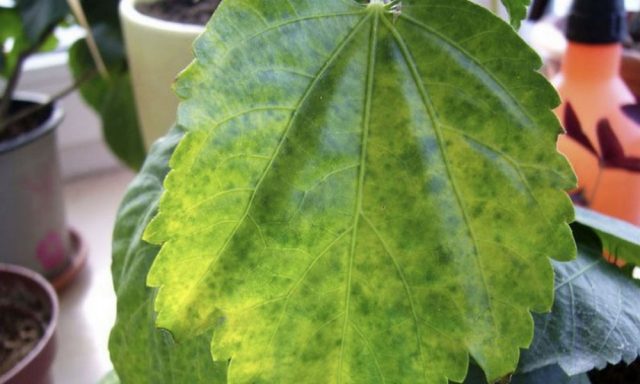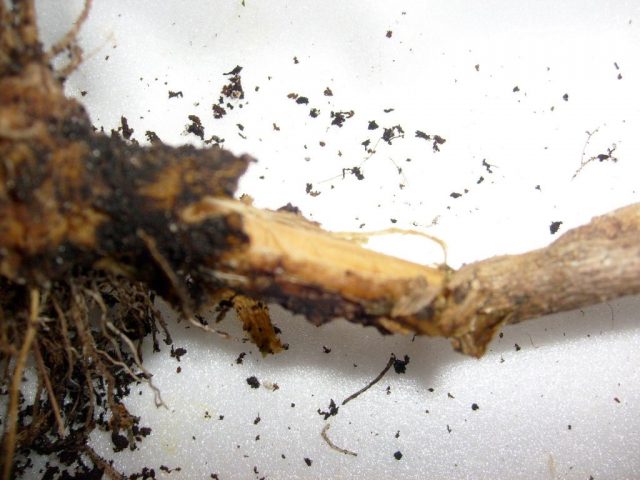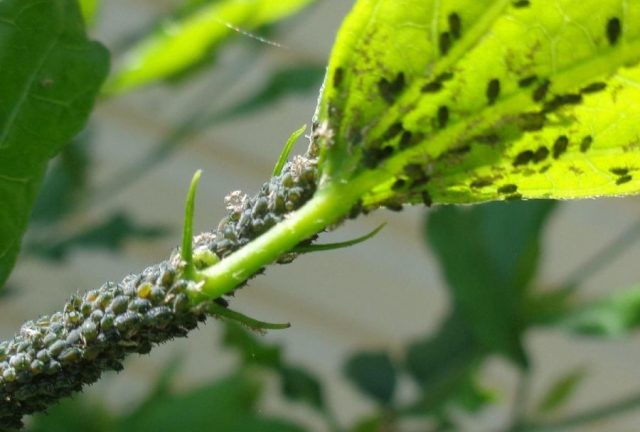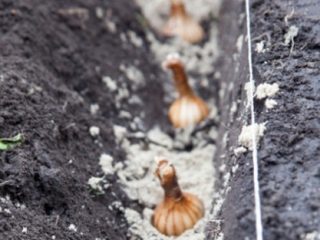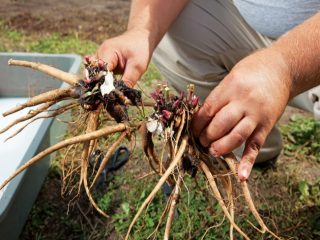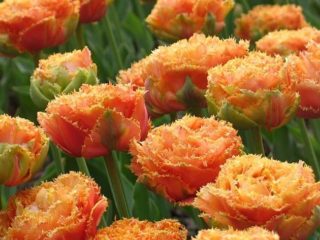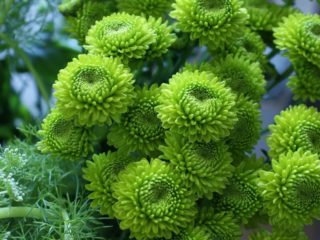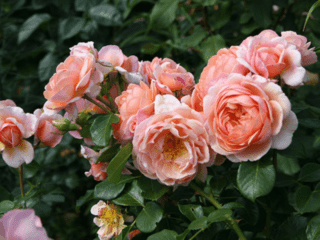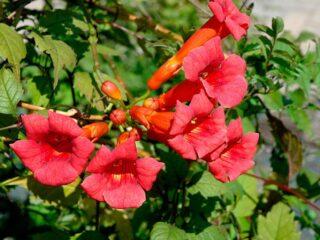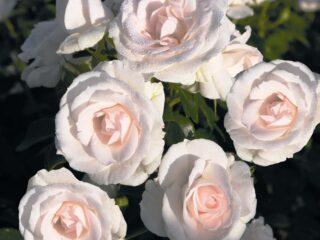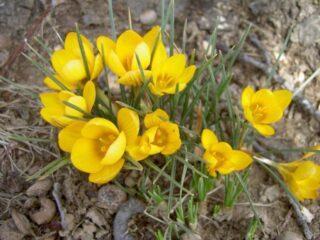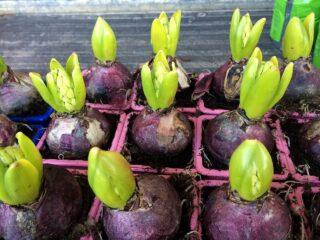Content
Syrian hibiscus is an ornamental plant represented by many species. It is easy to grow a crop on your site if you follow basic care rules.
Description of Syrian hibiscus
Syrian hibiscus (Hibiscus syriacus) is a plant of the Malvaceae family with a thick, tree-like, cone-shaped stem. The leaves of the shrub are palmate, slightly corrugated, green, up to 10 cm in length. Syrian hibiscus reaches an average of 5-6 in height.
During the flowering period, the culture blooms with single buds of a simple or double type. The petals can be white, crimson, red or bicolor depending on the variety. The fruit capsules are egg-shaped and contain pubescent seeds inside.
Frost resistance of Syrian hibiscus is low.In its natural form, the shrub is found in China, Korea and India, in the Crimea and the Caucasus. The crop is also grown in Central Asia, Moldova and southern Russia.
Varieties of Syrian hibiscus
Photos of Syrian tree hibiscus show that the culture is represented by a large number of ornamental varieties. Several species are in particular demand among gardeners.
Ardens
Ardens is a compact variety reaching only 2.5 m in height. It grows up to 2 m in diameter and has green, egg-shaped leaf blades. During the decorative period it bears large terry buds of lilac color. In the middle there is a large wine-colored stain. The variety is relatively frost-resistant, can withstand down to -15 °C if provided with shelter.
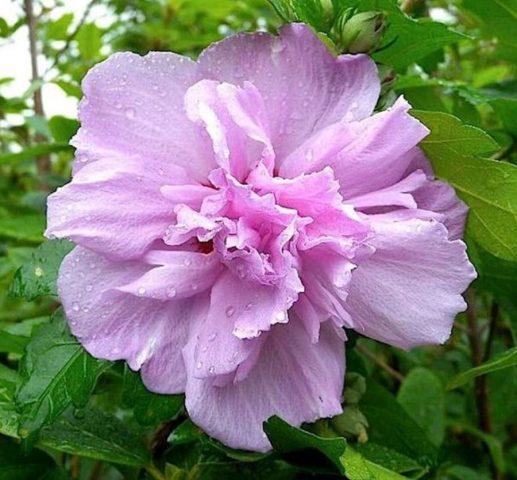
The buds of the Syrian hibiscus Ardens reach 10 cm in diameter
Blue Chiffon
Blue Chiffon is a shrub up to 1.5 m above ground level with ovate bright green leaves. At the end of spring it blooms with soft blue or bluish buds. The diameter of the inflorescences can reach 35 cm. The lifespan of the panicles is only about two days - they quickly bloom, reach maximum splendor and fade. A characteristic feature of the variety is that the petals have absolutely no purple or lilac shades.
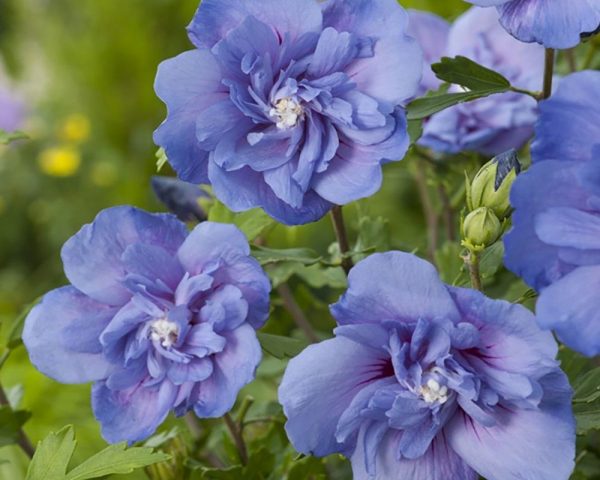
Blue Chiffon tolerates frost and drought well, but requires a lot of sun when growing
Lavender
Lavender is an ornamental shrub with abundant flowering from August to September. It has beautiful leaves, slightly reminiscent of chrysanthemum plates. The buds of the variety are semi-double, lavender in color, up to 10 cm in diameter.The base of the petals is dark burgundy, with radiant veins visible on the surface.
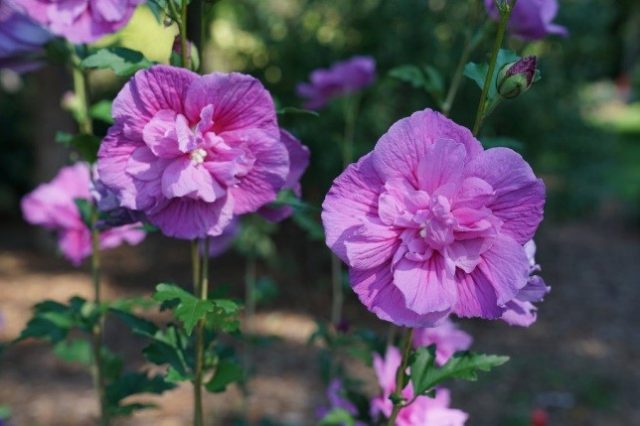
With good care, the Lavender variety can reach 4 m above the ground
Joan of Arc
Jeanne d'Arc is a variety of deciduous Syrian hibiscus with a tall but compact green crown. The shrub is capable of reaching 5 m above the ground, the width is 2-3 m. Photos of the Syrian double hibiscus show that from June to September it bears single lush buds of a milky white hue.
The variety is characterized by rapid growth, capable of adding up to 25 cm throughout the year. The total lifespan of the shrub is approximately 30 years.
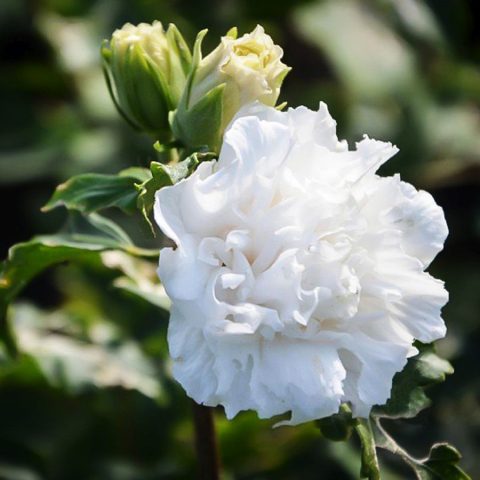
The Zhanna Dark variety develops well in illuminated areas with slightly acidic soil.
Mike
Syrian hibiscus Maike is a shrub up to 4 m above the ground with a diameter of about 3 m. It has good frost resistance and is rarely affected by fungal diseases. In early July it bears large buds up to 10 cm in diameter with pink petals. The core of the flowers is red, with crimson rays diverging to the sides. The decorative period continues until autumn.
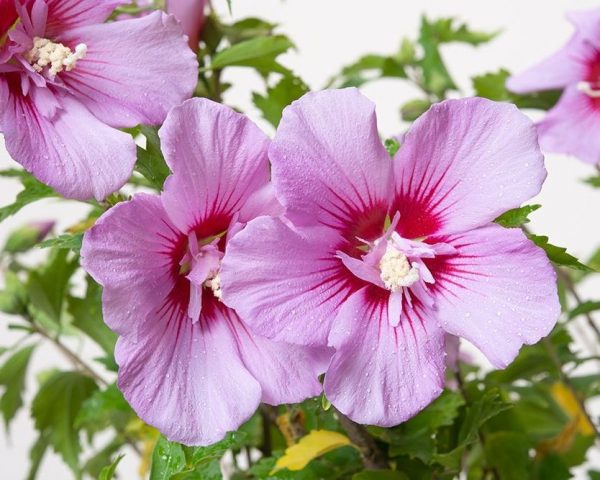
Unlike most hibiscus varieties, Maike grows very slowly.
Red Hart
Red Heart is a fast-growing compact shrub with dark green oval leaves. It has a dense crown, at the end of spring it bears large white buds, red in the middle. The bushes can spread up to 2.5 m wide.
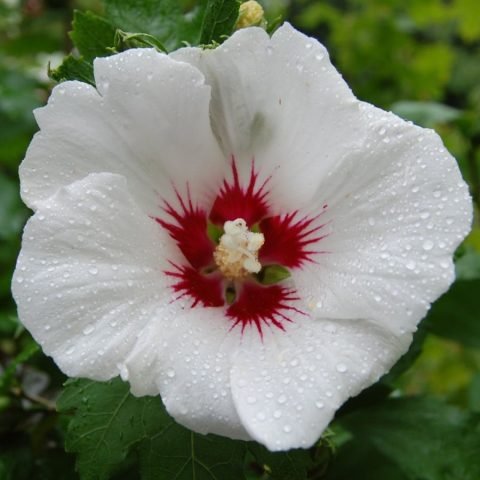
The height of the Red Heart variety is about 2 m
Matilda
Syrian hibiscus Mathilda is a beautiful tall variety up to 3 m above the ground. It is distinguished by abundant flowering at the end of summer - from August to September.The buds of the variety are light pink, with a crimson center, single, carmine stains and spots may be present on the petals. The shrub is afraid of sudden cold snaps and blooms worse in strong winds.
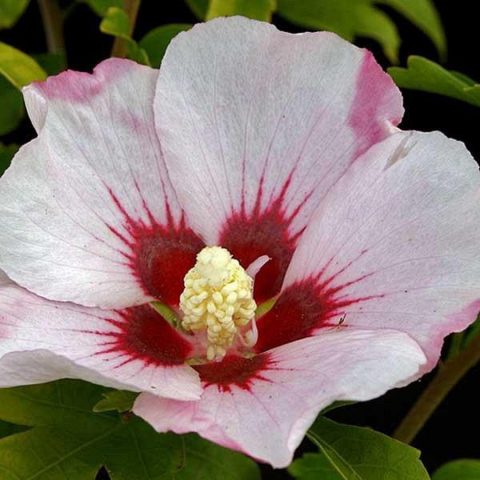
The Matilda variety can withstand winter frosts down to -30 degrees with good shelter.
Planting a Syrian rose
It is recommended to grow Syrian hibiscus on the site in a well-lit place with cover from strong winds. The soil must be fertile, slightly acidic or neutral in composition, with a high content of humus. The crop should not be placed in lowlands, on swampy and clayey soil. When choosing a site, it is necessary to take into account that Syrian hibiscus will remain in one place for about 15 years.
Planting is usually carried out in the spring in the middle or end of May. Most varieties have low frost resistance, so you need to wait for stable warming to at least 16 ° C. The site is first properly dug up, mineral fertilizers, peat and manure are added to the soil. Syrian hibiscus is planted in autumn in warm regions. In the Moscow region, the procedure is rarely performed at the end of the season due to the possibility of early frosts.
The algorithm for direct planting of a crop is as follows:
- A hole is prepared on the site, twice the size of the dimensions of the root system.
- A layer of sand and crushed stone is poured into the bottom of the hole to create drainage.
- Fill the hole halfway with nutritious soil and moisten it abundantly.
- Carefully remove the Syrian hibiscus from the previous container and transfer it to the prepared hole.
- Fill the remaining voids with soil and carry out another abundant watering.
To ensure that moisture from the ground evaporates more slowly, Syrian hibiscus can be mulched after planting. Sawdust, straw or wood chips may be used.
Features of care
You can grow Syrian hibiscus in the Moscow region in open ground without much difficulty. When caring for the crop, you need to pay attention to moistening and fertilizing, as well as the periodic formation of bushes.
Watering
When grown, Syrian hibiscus requires moderate but regular watering. In hot weather, the procedure is carried out on average once every two days; lukewarm and well-settled water is used for hydration. Watering should be done in the morning or in the evening after sunset, so that burns do not appear on the roots of the crop due to overheating under the bright sun.
During rainy periods, additional moisture can be completely abandoned. The shrub reacts poorly to swampiness and can begin to rot from excess watering.
Top dressing
Throughout the summer and early autumn, Syrian hibiscus requires regular feeding. The plant is usually fertilized with mineral preparations with a high phosphorus content. Fertilizer is applied once every two weeks in liquid form. At the beginning of spring, to increase the green mass, the shrub can be fertilized with nitrogen; in the summer it is recommended to also add potassium to the soil. It is allowed to alternate mineral fertilizers with organic matter. However, you should not use fresh manure - it can burn the roots of the plant.
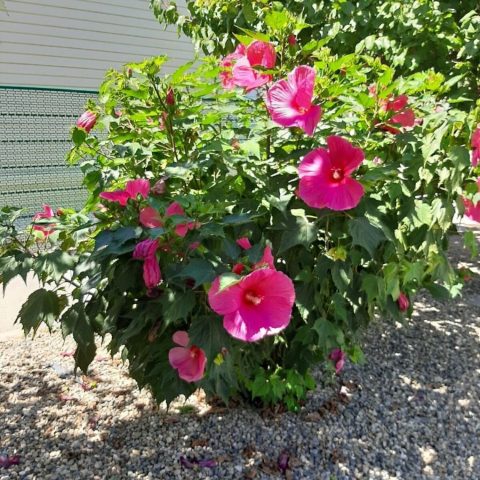
Syrian hibiscus responds well to feeding with wood ash in liquid or dry form.
Loosening
After each moistening, it is recommended to loosen the soil at the roots shallowly.This will increase the breathability of the soil and will have a good effect on the flowering of the shrub. Simultaneously with loosening, weeds are removed, robbing the crop of moisture and nutrients.
Pruning and shaping Syrian hibiscus
Ornamental trees and shrubs of Syrian hibiscus require regular pruning. In the spring, the plant undergoes a sanitary pruning, during which all frozen, dry and broken shoots are removed. In the fall, pruning is performed for the purpose of shaping; last year's branches are shortened by about 1/3 to give the bush the desired shape.
When growing Syrian hibiscus on a trunk, only the main shoot is left intact during pruning, and the lateral shoots are shortened to 1-3 buds. If you carry out the procedure in the fall, then next year the bush will bear especially large flowers. During spring formation, the buds will be smaller, but will appear on the branches in large numbers.
Wintering Syrian hibiscus
Syrian hibiscus in the Moscow region in winter requires very careful insulation. Most varieties can tolerate temperatures down to a maximum of -20 °C. With the onset of autumn, the shrub is mulched at the roots with a thick layer of humus or dry leaves, and then covered with spruce branches.
To strengthen endurance, you can feed the plant with phosphorus and potassium. If a very strong cold snap is expected, it is worth additionally covering the Syrian hibiscus along the crown for the winter - for example, wrapping it with agrofibre.
If we are talking about a young shrub, in the Moscow region it can be carefully removed from the ground in the fall and transplanted into a spacious tub.In this case, until spring, the crop is removed to a cool, but not prone to freezing, basement.
How to propagate Syrian hibiscus
Rooting Syrian hibiscus on a site can be done in several ways. Gardeners usually resort to two methods.
Propagation of Syrian hibiscus by seeds
You can grow Syrian hibiscus for your summer cottage from seeds. A short diagram looks like this:
- A wide box is filled with a nutrient substrate with the addition of peat and humus.
- Properly moisten the soil and make grooves in it up to 1 cm deep.
- Place the seeds in trenches and sprinkle soil on top.
- Moisten the substrate with a spray bottle and cover the box with plastic wrap.
During the first time after planting, the container must be ventilated daily, and the soil must be sprayed as necessary. When green shoots appear, the film will need to be removed. The seedlings are moved to a well-lit window and cultivation continues at home.
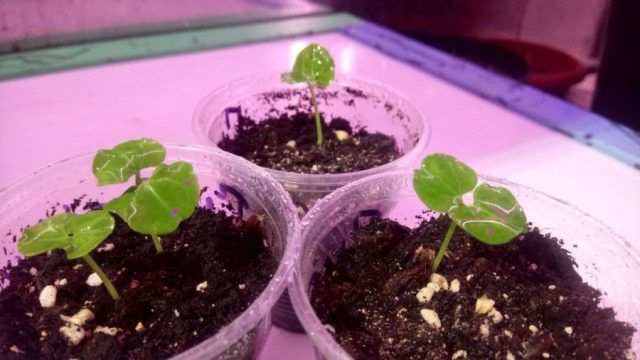
You can transfer hibiscus from seeds to open ground after the seedlings reach 20 cm in height and acquire 5-6 leaves
Cuttings from Syrian hibiscus
Propagation of Syrian hibiscus by cuttings is very popular. At the beginning of summer, a shoot with 3-4 nodes is cut off from a young healthy bush and placed in water with the addition of a growth stimulator.
When the cutting produces several white roots, it can be planted in a pot with a nutrient substrate. During the winter, the crop is grown at home, and next spring it is transferred to the ground.
Pests and diseases
Syrian hibiscus in general rarely suffers from fungi and insects. But the following may pose a danger to him:
- chlorosis - the leaves of the plant turn pale and yellow, lose their elasticity and fall off;
Chlorosis develops when there is a lack of nitrogen or iron in the soil
- root rot - Syrian hibiscus begins to shed its greenery and eventually dies completely;
Root rot provokes waterlogging of the soil
- aphids - you can recognize the presence of the pest by deformation of the leaves and the appearance of a sticky coating.
A soap solution and the drug Aktara help eliminate aphids on Syrian hibiscus
To prevent illnesses, it is recommended to keep the area clean and remove plant debris in a timely manner. The shrub should not be flooded or overfed with nitrogen. When the first symptoms of fungi appear, you need to cut off the affected parts of the plant, and then spray the crop with copper preparations or fungicides.
Conclusion
Syrian hibiscus is a fairly hardy but heat-loving plant. You can plant it in the Moscow region, but you should pay attention to the construction of high-quality winter shelter.
Reviews of Syrian hibiscus
